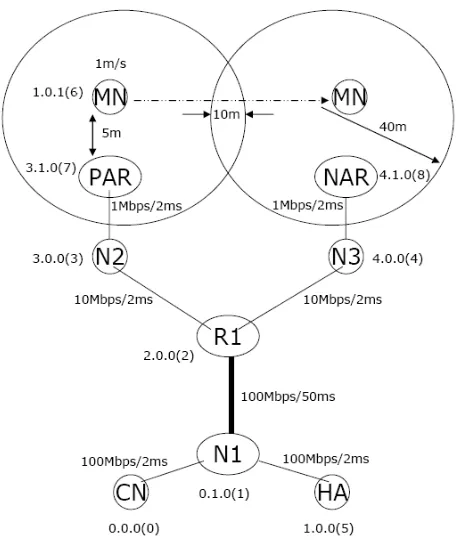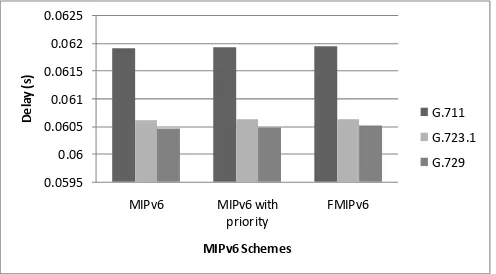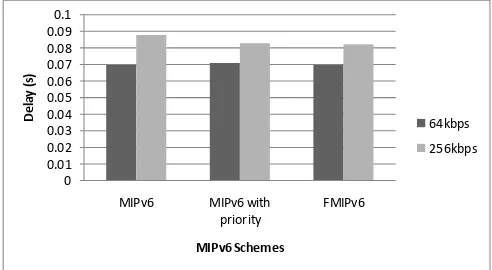Voice and Video Transmission with Mobile IPv6
Fakrulradzi Idris*, Norlezah Hashim
*Universiti Teknikal Malaysia Melaka, Malaysia. [email protected], [email protected].
Keywords: VoIP, H.263, MIPv6, FMIPv6, NS-2.
Abstract
Mobile IPv6 (MIPv6) is a protocol that is proposed for the future of the mobile Internet access. The aim of MIPv6 is to provide seamless communication services to mobile nodes. The aim of this study is to investigate the effect of real time applications: voice and video transmission on MIPv6 network. In this paper the implementation of MIPv6 and fast handover MIPv6 (FMIPv6) is modeled and simulated using Network Simulator 2 (NS-2) software. The performance is analyzed for three different voice coding schemes and video based on H.263 format for both MIPv6 and FMIPv6.
1 Introduction
The Voice over Internet Protocol (VoIP) and video transmission over the Internet are two real time applications that have strict requirements. A number of protocols are used to ensure that voice and video communications are appropriately established between parties. VoIP involves digitization of voice streams and transmitting the digital voice as packets over the Internet. The quality of real time applications are affected by several challenges such as available bandwidth, delay or network latency, packet loss, jitter, echo, security and reliability.
The Quality of Service (QoS) on VoIP network partly depends on the types of voice codec used [1]. The primary functions of a voice codec are to perform analog/digital voice signal conversion and digital compression. H.323 is a standard that specifies the components, protocols and procedures that provide multimedia communication services. H.323 specifies a series of audio codec ranging in bit rates from 5.3-64 kbps [2]. Three commonly used codec in VoIP are G.711, G.723.1, and G.729. The differences between these codecs are their coding rate, frame rate, and algorithmic latency that will influence the speech quality or Mean Opinion Source (MOS) in a VoIP network.
H.263 [3] is an ITU standard, designed for low bit rate communications. It is included in H.323 protocol suites and primarily used for video conferencing, video telephony, and Internet video application. H.263 is developed to stream video at bandwidths as low as 20kbps to 24kbps and based on H.261 codec. H.263 video streams need to be packetized for transportation over networks. The transport protocol for H.263 streams is the Real Time Transport Protocol (RTP).
In this paper, performance of three MIPv6 schemes; MIPv6, MIPv6 with priority and FMIPv6 are analyzed to evaluate three QoS parameters; packet loss, throughput and delay.
The paper is organized as follows. Section 2 discusses on the protocol overview of MIPv6. Section 3 presents the FMIPv6 operation to reduce handover latency and packet loss. Section 4 is the simulation methodology. Results and discussions are presented in section 5. Lastly in section 5, conclude the paper.
2 Mobile IPv6
In MIPv6 [4], each mobile node (MN) is identified by its IPv6 address called home address. The MN can always be reached using the fixed home address. When a MN is on its home link, it may be regarded as a wired node on link and any packet from the node will be handled using general routing protocols. When the MN is attached to a foreign link, it should be identified using Care of Address (CoA) as well as home address. The CoA provides information about the MN’s current location. The mobile node obtains the CoA using IPv6 stateless or stateful address configuration protocols. Once the MN gets CoA, it is required to register its current address to one of routers in its home link and requests the router to be a home agent. If the mobile node moves to another foreign link, it has to register its current location to the home agent and it may also inform the acquired CoA to CNs. Home registration is the process in which mobile node notifies its home agent of its movement with current location information. The home agent will update mobile node’s new location and the association between the home address and CoA is called binding. Some benefits of MIPv6 are foreign agents are not necessary, possible use of route optimization and allows nodes on link to be independent on link layer protocols.
3 Fast Handover Mobile IPv6
commonly causes a period of communication interruption. In FMIPv6, occurrence of a handover is predicted by detecting the movement of MN. Several portions of L3 handover are performed in advance prior to the handover, such as New Care of Address (NCoA) configuration and movement detection. A tunnel is established between Previous Access Router (PAR) and New Access router (NAR) so that packet loss can be prevented. As the result, the handover latency of the MN is reduced effectively. In FMIPv6, when roaming to a new network is predicted by MN, a Router Solicitation for Proxy Advertisement (RtSolPr) message is sent to PAR to obtain a NCoA. Then a Fast Binding Update (FBU) message is sent to PAR by the MN, and a tunnel is established between PAR and NAR, which is used for forwarding data packets between them. As soon as the MN arrives to the new network and finishes L2 connection, it sends a Fast Neighbor Advertisement (FNA) message to NAR. On receipt of this message or L2 connection gets ready, NAR starts to deliver packets to the MN. Operations of FMIPv6 are composed of predictive mode and reactive mode.
4 Methodology
In this part, simulation topology and parameters are presented to compare the performance of MIPv6, MIPv6 with priority, and FMIPv6. Previous simulation model based on ns-allinone-2.1b7a as in [6] is ported to ns-allinone-2.28 according to [7]. Functions in MIPv6 and FMIPv6, namely route optimization and DAD are not used in the simulation. The L2 handoff delay is set to 20ms. The network scenario for the simulation is shown in Figure 1.
Figure 1: Network Scenario
The simulation environment consists of a corresponding node (CN), a streaming real time traffic over user datagram protocol (UDP) a MN, home agent (HA), gateway router N1, common router R1, routers N2 and N3, also previous access router (PAR) and new access router (NAR). The IEEE 802.11b is used as access technology and each access router has coverage area of 40 meters in radius with the overlapping region between PAR and NAR is 10 meters. The bandwidth and link delay between two intermediate wired nodes, also the hierarchical address and node number are set as shown in Figure 1.
For VoIP, traffic between CN and MN are generated as Constant Bit Rate (CBR). The CN produces a CBR traffic source, transmitting packets in an RTP over UDP medium. A one-way VoIP connection is modeled as a stream of packets with a fixed packet size and transmission rate. The CN produces payload according to the voice coding payload size. The standard method of transporting voice packets through wireless local area network (WLAN) requires the addition of three headers. There are IP, UDP and RTP. An IPv6 header is 20 octets, a UDP header is 8 octets and RTP header is 12 octets. A total of 40 octets are sent each time a packet containing voice payload is transmitted. The main characteristics of the voice codecs used in the simulation are summarized in Table 1.
Parameters G.711 G.723.1 G.729
Bit rate (Kbps) 64 6.3 8
Framing interval
(ms)
20 30 10
Payload (Bytes) 160 24 10
Packets/s, Np 50 33 100
Table 1: Audio/Voice codec parameters
The MN acts as a sink, by receiving the packets from the CN at a constant inter-arrival rate. Loss monitor agent is attached to the MN to record the packet loss and throughput of the receiving packets.
A real H.263 video encoding provided by [8] (film: ”Die Hard III”) for target bit rate of 64kbps and 256kbps is used as real time video traffic. The obtained frame sizes of the individual encoded video frames are used as input for the NS-2 real time video traffic application.
The two-ray ground reflection model is used in the simulation. This model considers both the direct path and a ground reflection path. The received power Pr at a distance d from the transmitter for the two-ray ground reflection model can be expressed as Equation (1).
��(�) =��������
2�
�2
�4� (1)
The power level at which the packet was received at MAC layer is compared with the receiving threshold (RTX) and the carrier-sense threshold (CTX). If the power level falls below the carrier sense threshold, the packet is discarded as noise. If the received power level is above the CTX but below the RTX, the packet is marked as a packet in error before being passed to the MAC layer. Otherwise, the packet is simply handed up to the MAC layer. In NS-2, the transmitting power Pt is set to 0.03162 Watt, correspond to 15dbm. In this
simulation model, the RTX is set 40 meters, and the CTX with respect to the transmitting station, is set to 90 meters. Therefore the RTX and the CTX can calculated as 1.90448e-9 and 3.76193e-10
The voice and video transmission are simulated for three types of MIPv6 schemes. MIPv6 differ from MIPv6 with priority because no priority is assigned to PAR and NAR. FMIPv6 is similar to MIPv6 with priority but the fast handover predictive mode is enabled.
, respectively. The height of the Omni-directional antennas is 1.5m above the ground plane operating in the 2.432 GHz frequency.
5 Results and Discussion
The packet loss, throughput and delay for MIPv6, MIPv6 with priority and FMIPv6 schemes are obtained by analyzing the output files produced by NS-2 simulations. Trace2stats [9] and Tracegraph [10] are used to measure the average throughput and delay for the network. During handover process from PAR to NAR, packet loss is observed only in MIPv6 scheme as shown in Figure 2. From the figure, the average numbers of packet loss are 94, 59, and 224 for G.711, G.723.1, and G.729 codec respectively. The number of packet loss is proportional with the number of packets sent by the CN per second.
Figure 2: Packet loss in MIPv6
The throughput of receiving bits at MN for VoIP application is shown in Figure 3. There is a very slight difference for MIPv6 with priority and FMIPv6 schemes. The throughput value for MIPv6 is the lowest since packet loss occur during the handover process between PAR and NAR.
0
Figure 3: VoIP throughput
Figure 4 shows the end to end delay between the CN and MN. In term of delay performance, it is found that the delay is proportional to the size of the VoIP packet as shown in the figure. The larger the packet size, the longer it takes to transmit the packet from the CN to the MN. FMIPv6 scheme experience the longest delay due to the additional signalling message transmitted during the handover process. The transmission delay also contributed by the time it takes to tunnel the packets from PAR to NAR.
Figure 4: VoIP delay
0 50000 100000 150000 200000 250000 300000
MIPv6 MIPv6 with priority
FMIPv6
T
h
ro
u
g
h
p
u
t (
b
p
s)
MIPv6 Schemes
64kbps
256kbps
Figure 5: H.263 video throughput
The end to end delay between the CN and MN during H.263 video transmission is shown in Figure 6. For the target bit rate of 64kbps, all schemes recorded approximately 70ms of delay. The delay performance for the target bit rate of 256kbps is completely different when compare to VoIP delay. Here, the delay for FMIPv6 is the lowest, followed by MIPv6 with priority and MIPv6.
0 0.01 0.02 0.03 0.04 0.05 0.06 0.07 0.08 0.09 0.1
MIPv6 MIPv6 with
priority
FMIPv6
D
e
la
y
(
s)
MIPv6 Schemes
64kbps
256kbps
Figure 6: H.263 video delay
6 Conclusion
In this paper, we investigate the performance of three MIPv6 schemes for real time traffics transmission in WLAN. We analyze the performance by simulating three MIPv6 schemes in NS-2 to get the results in terms of packet loss, throughput and delay. As can be seen, MIPv6 has the disadvantages of experiencing packet loss during the handover process for VoIP transmission, and also recorded the lowest throughput for voice and video transmission. The performance of MIPv6 with priority is approximately equal to FMIPv6 but FMIPv6 outperformed the other two MIPv6 schemes for H.263 video application. For future work it would be interesting to evaluate the performance of fast handover Mobile IPv6 in WiMAX networks.
Acknowledgements
The authors would like to thank Universiti Teknikal Malaysia Melaka (UTeM) for funding this project.
References
[1] D. Minoli, E. Minoli. “Delivering Voice over IP Networks”, Second Edition, United States of America: Wiley Publishing Inc, 2002.
[2] S. K. Das, E. Lee, K. Basu, S. K. Sen. “Performance Optimization of VoIP Calls over Wireless Links Using H.323 Protocol”, IEEE Transaction on Computers, vol. 52, pp. 742-752, (2003).
[3] ITU-T. “Video coding for low bit rate communication”,
ITU Recommendation H.263, ( 2005)
[4] C. Perkins, D. Johnson, J. Arkko. Mobility Support in IPv6, Jun 2004.
[5] R. Koodli, Fast Handovers for Mobile IPv6, July 2005. [6] R. Hsieh, A. Seneviratne, H. Soliman, K. El-Maliki.
“Performance Analysis on Hierarchical Mobile IPv6 with Fast-handoff over End-to-End TCP”, Proceeding of
GLOBECOM, (2002).
[7] S. Yankov, S. Wiethoelter. “Handover Blackout Duration of Layer 3 Mobility Management Schemes”,
TKN Technical Report, 2006.


